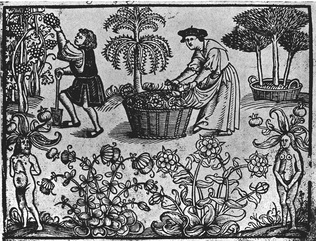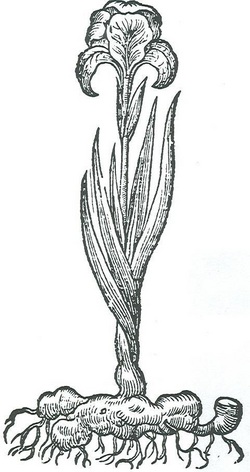Banckes' Herbal
The first book printed in Britain which is a herbal "in the strictest sense" (not just containing some references to botanical information) was printed in 1525 by Rycharde Bankes. It may be that the book was completely original, but it is assumed to be based on some earlier "unknown medieval manuscript dealing with herbs." A smaller amount of space is devoted to the "virtues of plants" than the later Grete Herball, but more botanical information is given. Banckes' Herbal did not contain illustrations (Arber, 1986).
The Grete Herball

Woodcut from the title page of the "Grete Herball" (1526).
The most famous and widely known of the early printed herbals was the Grete Herball printed by Peter Treveris (c. 1526). According to the introduction it was compiled from the works of 'many noble doctoures and experte maysters in medecines [sic]'."This book was a translation of a French herbal entitled Le Grant Herbier, which itself was a translation of either the German herbal named Herbarius zu Teusch (c. 1485) or the Latin Circa Instans (c. 1458) (Rohde, 1974). It is said that the bibliographic confusion revolving around he source of Le Grant Herbier, and therefore the Grete Herball, is practically unrivaled in herbal literature due to "problems of anonymity, uncertain dates, fictitious personalities, and dubious editions" (Anderson, 1977).
"The Grete Herball is alphabetically arranged, for the idea of the natural relationship of plants was unknown at that time." However, there is a classification of Fungi (Rohde, 1974).
As in many other herbals, there are descriptions of other things besides plants, for instance the Grete Herball has a fairly detailed description of "mommye" or mummies and the "spyces" and "baumes" used to treat them! Other non-plant treatments include "salt, cheese, pitch, lead, silver, gold, amber, water, starch, vinegar, butter, honey...the lodestone [and bathing]. (Blunt & Raphael, 1980; Rohde, 1974)"
"The Grete Herball is alphabetically arranged, for the idea of the natural relationship of plants was unknown at that time." However, there is a classification of Fungi (Rohde, 1974).
As in many other herbals, there are descriptions of other things besides plants, for instance the Grete Herball has a fairly detailed description of "mommye" or mummies and the "spyces" and "baumes" used to treat them! Other non-plant treatments include "salt, cheese, pitch, lead, silver, gold, amber, water, starch, vinegar, butter, honey...the lodestone [and bathing]. (Blunt & Raphael, 1980; Rohde, 1974)"
Gerard's Herbal

Lily woodcut illustration.
Gerard's Herbal (c. 1597) "gripped the imagination of the English garden-loving world." In modern times as well as his own, Gerard's Herbal earned condemnation for his undeclared use of a translation of Dodoens' Pemptades (Blunt & Raphael, 1980). "John Norton, the Queen's printer, had commissioned Dr. Priest, a member of the College of Physicians, to translate Dodoens' Pemptades from Latin into English. Priest died before he finished his work and the unfinished translation came somehow into Gerard's hands. Gerard altered the arrangement of the herbs from that of Dodoens to that of de l'Obel in his Adversaria, and of Priest's translation her merely says: 'Dr. Priest, one of our London College, hath, (as I heard), translated the last edition of Dodoens, which meant to publish the same, but being prevented by death his translation likewise perished'" (Rohde, 1974).
The structure of the herbal was taken from Dodoens, yet Gerard's additions are that which gives it charm. There are at least 1800 illustrations from wood blocks in the herbal (Blunt & Raphael, 1980). These blocks were procured by the Queen's printer from Nicolas Bassaeus of Frankfurt. Gerard's additions also include his own "observations, numerous allusions to persons and places of antiquarian interest, and a good deal of contemporary folk-lore." Gerard mentions his own friends and "one realises...that he received plants from all...parts of the globe." He "gives so much contemporary folk lore that before we have been reading long we feel as though we were wandering about in Elizabethan England with a wholly delightful companion" (Rohde, 1974).
The structure of the herbal was taken from Dodoens, yet Gerard's additions are that which gives it charm. There are at least 1800 illustrations from wood blocks in the herbal (Blunt & Raphael, 1980). These blocks were procured by the Queen's printer from Nicolas Bassaeus of Frankfurt. Gerard's additions also include his own "observations, numerous allusions to persons and places of antiquarian interest, and a good deal of contemporary folk-lore." Gerard mentions his own friends and "one realises...that he received plants from all...parts of the globe." He "gives so much contemporary folk lore that before we have been reading long we feel as though we were wandering about in Elizabethan England with a wholly delightful companion" (Rohde, 1974).
References
- Anderson, F. J. (1977). An illustrated history of the herbals. New York: Columbia University Press.
- Arber, A. (1986). Herbals, their origin and evolution: A chapter in the history of botany 1470–1670. Cambridge: Cambridge University Press. Blunt, W. & Raphael, S. (1980). The illustrated herbal. London: Francis Lincoln.
- Rohde, E. S. (1974). The old English herbals. London: Minerva Press.
